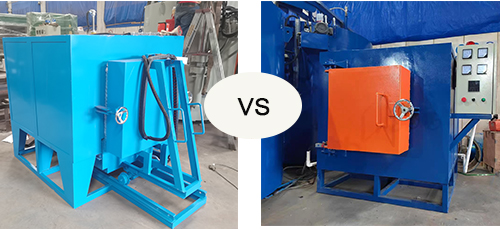Comparison between Box-type Heat Treatment Furnace and Car-bottom Heat Treatment Furnace
Feb. 14, 2025
Box-type and car-bottom heat treatment furnaces exhibit significant differences in structure, functionality, and applicable scenarios. Below is a detailed comparison of the two:
I. Structural Characteristics
Box-type Heat Treatment Furnace
Box Structure: Typically adopts a fixed box structure with a relatively small furnace door but better sealing performance.
Sealing Method: The furnace door and furnace body are sealed automatically, eliminating the need for manual sealing. The excellent sealing facilitates precise temperature control.
Electric Heating Elements: Made by winding high-resistivity iron-chromium-aluminum or nickel-chromium alloy wire into a spiral and placed on both sides of the furnace hearth and on refractory bricks at the furnace bottom, which is covered with a heat-resistant steel plate.
Car-bottom Heat Treatment Furnace
Car Design: Features a movable car design facilitating easy loading and unloading of materials. The larger furnace door accommodates the ingress and egress of large workpieces.
Sealing Devices: Compared to box-type furnaces, car-bottom furnaces include additional devices for powering the electric heating elements on the car, sealing between the car and furnace body, and driving the car. However, the sealing of car-bottom furnaces is not as good as that of box-type furnaces, especially when the furnace door is opened and heat escapes during workpiece retrieval.
Electric Heating Elements: Generally powered through contacts, with fixed contacts at the tail and spring-loaded moving contacts at the rear of the furnace body to ensure good contact when the car enters the furnace chamber.
II. Functional Characteristics
Box-type Heat Treatment Furnace
Temperature Control: Due to its excellent sealing and temperature control system, it can provide a more precise and uniform temperature environment, crucial for processes requiring precise heating control.
Loading Capacity: High loading capacity and productivity, especially suitable for heat treatment of small to medium-sized machine parts.
Operational Convenience: Easy to load materials and operate. Additionally, the furnace is equipped with interlocking protection devices to prevent faults and accidents due to misoperation.
Car-bottom Heat Treatment Furnace
Loading Convenience: Allows for easy pushing and pulling of large or heavy workpieces in and out of the furnace chamber, beneficial for batch processing or handling large workpieces.
Temperature Uniformity: Although it can also provide good temperature control, its open car design and larger furnace door may slightly compromise temperature uniformity compared to box-type furnaces. However, adopting technologies such as high-speed burners and forced furnace gas circulation can improve temperature uniformity to some extent.
Environmental Performance: Pollution-free and fully compliant with national environmental protection requirements.
III. Applicable Scenarios
Box-type Heat Treatment Furnace
More commonly used in experiments or production processes requiring precise temperature control and high-temperature environments, such as sintering, melting, or heat treatment of materials like ceramics and glass.
Also suitable for annealing, normalizing, quenching, tempering, carburizing, and other heat treatments of small parts and small-batch production.
Car-bottom Heat Treatment Furnace
Often used for batch heat treatment of large workpieces, such as melting, forging, and heat treatment processes for steel and non-ferrous metals.
Also applicable for annealing, normalizing, and tempering of large and bulk metal workpieces.
In summary, box-type and car-bottom heat treatment furnaces each have their unique characteristics and advantages. When selecting, comprehensive consideration should be given based on specific application needs and process requirements.










